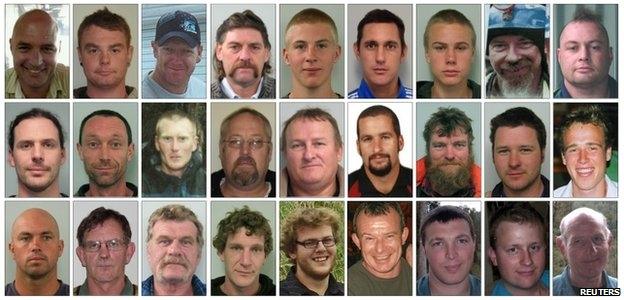New Zealand miners' recovery could take months, says PM
- Published

The operator of the mine said it would make every effort to retrieve the men's bodies. Francis Skiddy Marden and Stuart Gilbert Mudge are not pictured
New Zealand's Prime Minister John Key has warned it may take months to recover the bodies of 29 men killed in an accident at the Pike River mine.
Speaking in Greymouth on the South Island, near the coal mine, he promised an investigation into the accident, saying the nation "needs answers".
The men were trapped last week and declared dead on Wednesday after a second explosion.
Messages of condolences have poured in from around the world.
Flags have been flying at half-mast and people have been gathering in churches across New Zealand for special services to mourn the 29 miners.
Members of parliament in the capital, Wellington, wore black and paid tribute to the men, singing the hymn How Great Thou Art.
John Key: "There are some basic questions that need to be answered"
Mr Key met the grieving families of the miners in Greymouth and said all New Zealanders were "deeply sorry" for their loss.
He said an independent commission of inquiry would "leave no stone unturned" into the cause of the explosions that trapped and most likely killed the miners.
"We need answers to what happened at Pike River. Clearly something's gone terribly wrong and it's now claimed the lives of 29 people," he said.
"And I think for the families, they now have accepted that their loved ones have gone, but they want answers. They also want their men removed from the mine."
The recovery operation could only take place "in a way that is safe to those that would undertake that mission", he said, adding that international experience showed this could take months.
No 'window of opportunity'
A mix of poisonous and combustible gases remained in the mine and there was the risk of further explosions at any time, said the CEO of Pike River Coal, Peter Whittall.
A rescue team had been preparing to enter the mine on Wednesday when gas levels spiked. The mission was called off just before the second explosion, Associated Press news agency said.
Trevor Watts, of New Zealand Mines Rescue, said there had been no "window of opportunity" for rescuers to enter the mine immediately after the first explosion on Friday, as some angry relatives have charged.
"It wasn't for the want of trying, or the willingness or the courage or the bravery of those that would have gone in to undertake the rescue - it was just the reality of the situation," Mr Key said.
Even before the second blast ended hopes of survival, rescuers did not manage to make contact with the miners - who included 24 New Zealanders, two Australians, two Britons and a South African.
Condolences
Local high school principal Jim Luders said Greymouth, home to many of the miners, said he was devastated by events.
"Everyone here knows someone who's down the mines and that's what makes it so intensely personal," he told Radio New Zealand.
The UK's Queen Elizabeth, who is New Zealand's head of state, said she was deeply saddened by the disaster.
"I send my thanks and deep appreciation to everyone who has worked so hard to attempt a rescue, and also to those who will have a part to play in the task of healing the pain that is being felt throughout New Zealand and around the world," she said.
The board of Pike River Coal was to meet on Friday to discuss the future of the mine - seen as an economic lifeline for the region when it opened in 2008.
Analysts say New Zealand's mines have a good safety record, and this was the worst disaster for almost a century.
Pike River is not far from the Strongman mine, where an underground explosion killed 19 men in January 1967.
New Zealand's worst mining disaster was in 1896, when a gas explosion at the Brunner mine, also near Greymouth, left 65 miners dead. It accessed the same coal seam as the Pike River mine.

- Published25 November 2010
- Published24 November 2010
- Published24 November 2010
- Published24 November 2010
- Published24 November 2010
- Published24 November 2010
- Published14 October 2010
- Published22 November 2010